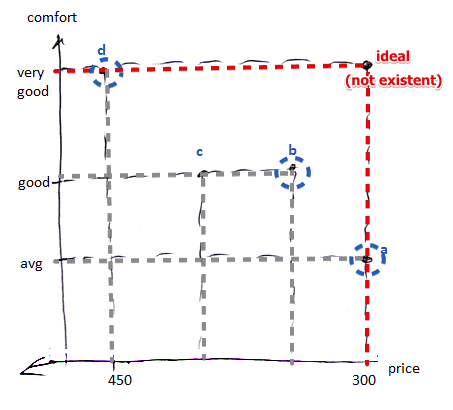Multi-Objective Optimization
In contrast to Uni-Objective Optimization problems, in Multi-Objective Optimization problems there are multiple
An usual model is:
- $\text{opt} f_1(x), …, f_q(x), x \in A$
- but usually in this case there is no single ‘‘optimal’’ solution - but a set of solutions where you cannot say which one is better
Example:
- suppose you want to buy a flat
- there are 2 criteria: cost and comfort
- you want to minimize the cost and maximize the comfort

- note that you cannot say that $d$ is better than $b$ or better than $a$
- but $c$ is clearly dominated by $b$: it’s as comfortable as $c$, but cheaper
- the set of the best alternatives is called the ‘‘Pareto-optimal’’ set of alternatives
Multi-Criteria Problem
We have $q$ criteria and $n$ items | | Criterion 1 | Criterion 2 | … | Criterion $q$ | Item 1 | 100 | Medium | … | 8 || Item 2 | 100 | Medium | … | 8 || … | … | … | … | … || Item $n$ | 55 | Very Bad | | 8 | Goal: to rank the items
- there are lots of conflicting criteria (like price and comfort)
- there are different units and scales
- the single optimal solution does not exist
Instead of “Item” it can be “Action”, “Alternative”, etc
Formally we can write it as:
- objective: $\text{opt} z(x)$
- $z: \mathbb{R}^n \to \mathbb{R}^m$
- constraints: $g_i(x) \geqslant 0, x \in \mathbb{R}^n$
Link to Voting Theory
But it is possible to draw a direct parallel with Voting Theory| | || | Voter 1 | Voter 2 | … | Voter $q$ | Candidate 1 | 100 | Medium | … | 8 || Candidate 2 | 100 | Medium | … | 8 || … | … | … | … | … || Candidate $n$ | 55 | Very Bad | | 8 | So these two problems are similar:
- Each voter ranks all candidates (alternatives)
- We apply some voting mechanism and find the global preference (the “best” alternative)
- All properties of Voting Theory are still available:
- Unanimity,
- Monotonicity,
- Independence to Third Alternatives
- and others
However there are differences:
- Not all criteria have the same weight
- in Voting Theory all votes are equally important
- here some criteria may be more important than others
- We need more information than just ranking
- There are different scales
- Since the scales can be numerical, we can compare the intensity of preference
Multi-Objective Optimization Problems
Choosing the Solution
Suppose we have obtained the Pareto-optimal set of solutions. How do we choose the “best” solution?
There are several approaches:
Multi-Criteria Decision Aid
Also MCDA is used for that:
- find the Pareto-optimal solutions
- apply MCDA to find the best one